Executive Summary
Wastewater treatment processes produce sewage sludge,which has to be discharged after an appropriate treatment. Nowadays, there are several new technologies in use or in development. The main aims of these methods are recovery and reuse of either the nutrients or the energy at acceptable costs. Besides the production of biogas in anaerobic digestion, the calorific value of sludge can also be recovered in the form of heat.
| In | Out |
|---|---|
Energy |
Introduction
The costs for sewage sludge treatment often represent more than 50% of total wastewater treatment costs. Looking into the future, sludge management will consist in innovative treatment methods focussing on three aspects:
- Recovery and reuse of valuable products from sludge (nutrients or heat).
- Complete solution of the sludge problem (final disposal), especially regarding toxins.
- Acceptable costs.
In this respect, it can be expected that the recovery of sustainable energy from sewage sludge will become more and more of interest (RULKENS 2007). In this factsheet, each one of the following techniques are introduced down below:
- Anaerobic digestion of sewage sludge
- Production of biofuels from sewage sludge
- Direct production of electricity from sewage sludge in microbial fuel cells,
- Incineration of sewage sludge with energy recovery
- Co-incineration of sewage sludge in coal-fired power plants
- Gasification and pyrolysis of sewage sludge
- Use of sludge as an energy and raw material source in the production of Portland cement and building materials,
- Supercritical wet oxidation of sewage sludge
- Hydrothermal treatment of sewage sludge
Anaerobic Digestion of Sewage Sludge
Large-scale anaerobic biogas digesters are reactors used for the conversion of the organic fraction of large volumes of slurries and sludge into biogas by anaerobic digestion. Biogas is recovered and used either directly for heating the reactors or transformed into combined power and heat and fed into the grid. Read more about anaerobic digestion in general or large scale anaerobic digestion.
Production of Biofuels from Sewage Sludge
An overview of the various conservation processes (either liquid or gaseous energy carriers from biomass) are given by CLAASSEN et al. (1999). What type of energy carrier is produced strongly depends upon the types of microorganisms and the applied process conditions. Depending upon the type of microorganisms, energy carriers, such as methane, ethanol, acetone, butanol, or hydrogen, can be produced. For sewage sludge, by far, the most information is available on the production of biogas (methane, see anaerobic digestion). There are not many studies about the production of ethanol, butanol, or acetone from sewage sludge. One reason could be that the process to separate the components is very complex and therefore less attractive (RILKENS 2007). There are a few studies about the production of hydrogen from sewage sludge, e.g. TING and LEE (2006). Another approach is to produce biodiesel from waste sludge. Nowadays, sources for biodiesel are vegetable oils or animal fats, which are quite expensive (pure vegetable or seed oils constitute between 70% and 85% of the overall biodiesel production cost). On the other hand, biodiesel production from sludge could be very profitable in the long run (KARGBO 2010).
Direct Production of Electricity from Sewage Sludge in Microbial Fuel Cells
Microbial fuel cells can be used to directly produce electricity from a wastewater stream, such as municipal wastewater containing biodegradable organic compounds. In the figure to the left, a schematic presentation of a microbial fuel cell is given. Basically, a microbial fuel cell consists of an anode chamber and a cathode chamber separated from each other by a cation exchange membrane.In the anode chamber, organic compounds present in the wastewater, such as carbohydrates, are oxidised by specific microorganisms (RULKENS 2007). You can find more information about it in AELTERMAN et al. (2006) or LIU et al. (2004).
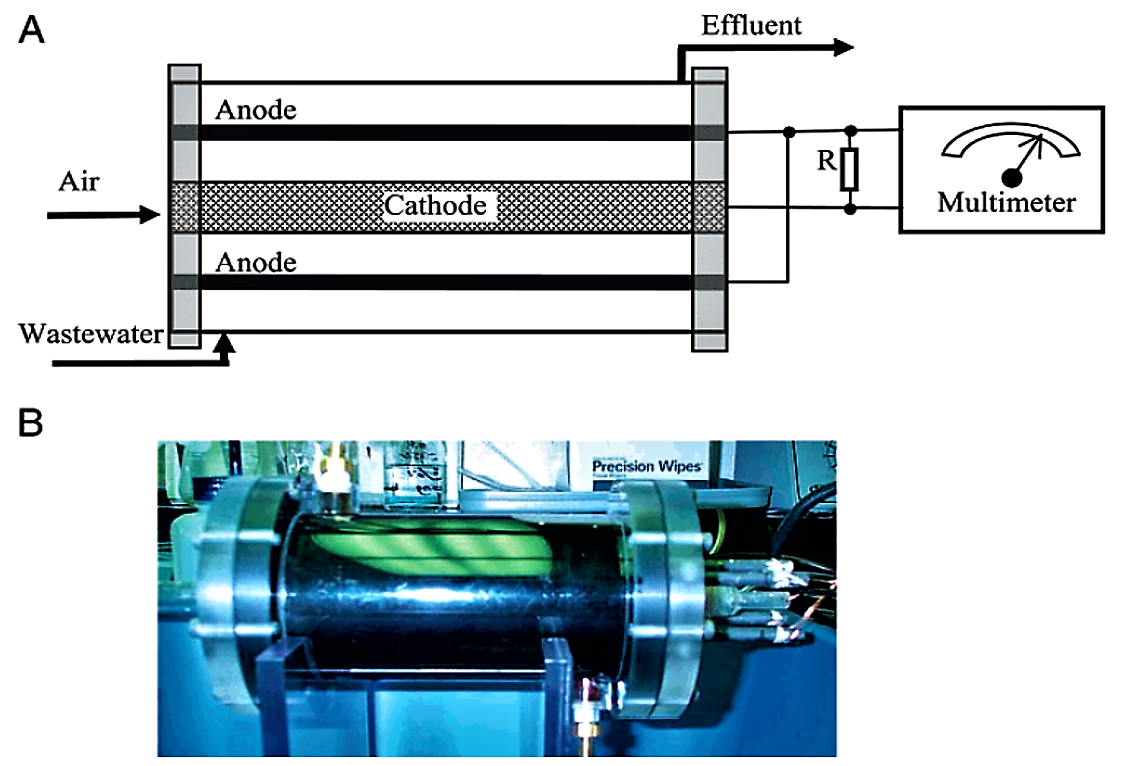
Incineration of Sewage Sludge with Energy Recovery
Adapted from RULKENS (2007)
Incineration (either small scale or large scale) of sewage sludge is aimed at a complete oxidation at high temperature of the organic sludge compounds, also including the toxic organic compounds. The process can either be applied to mechanically dewatered sludge or dried sludge (e.g. drying beds). Potential environmental problems related to sludge incineration are the emissions of pollutants with the exhaust gases to the atmosphere as well as with the quality of the ashes.
The energy produced in the incineration process can be used for the drying of the mechanically dewatered sludge cake prior to the incineration process or can be used for the production of electricity. Currently, sludge incineration processes are increasingly focused on the recovery of energy from the sludge in the form of heat (steam) or electricity. Incineration of sludge is currently applied worldwide more and more in combination with energy recovery, mainly on a large scale.
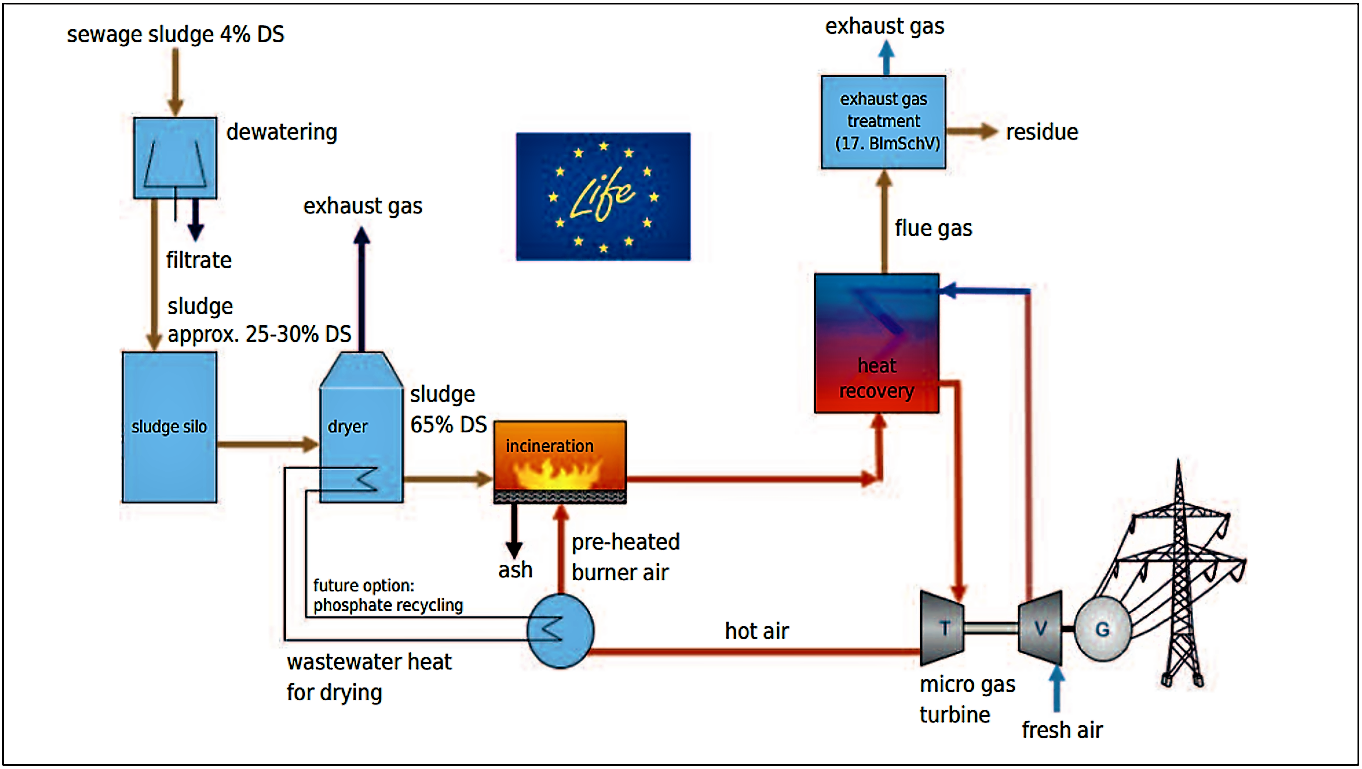
Co-Incineration of Sewage Sludge in Coal-Fired Power Plants
Adapted from RULKENS (2007)
To avoid the high costs of a stand-alone incineration plant for sludge and to improve the energy recovery efficiency, possibilities have been investigated to incinerate dried sludge in a coal-fired power plant. In this case, beneficial use can be made from existing coal combustion installations and existing exhaust gas treatment systems. Because the amount of incinerated sludge is small compared to the amount of coal, the effect of the incineration of the sludge on the air and ash qualities can be neglected. The energy recovery from the incineration of the sludge can often be strongly increased by improvement of the dewatering and drying processes of the sludge and probably also by the use of the low-caloric waste heat from the exhaust gases of the power plant. Also, the use of the polluted drying gas in the incineration process can contribute to a better total process performance. Apart from co-incineration of sewage sludge in coal-fired power plants, other co-incineration processes (such as in combination with municipal waste), are also currently practised.
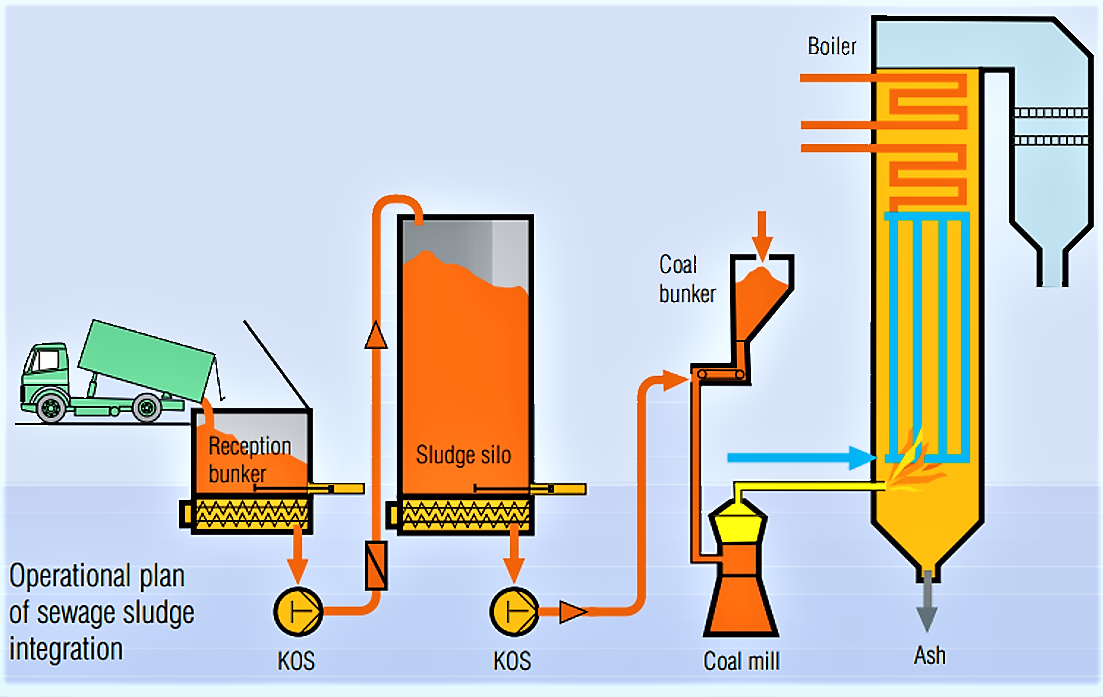
Gasification and Pyrolysis of Sewage Sludge
Adapted from RULKENS (2007)
Pyrolysis is a thermal treatment process in which the sludge (or biomass) is heated under pressure to a temperature of 350–500°C in the absence of oxygen. In this process, the sludge is converted into char, ash, pyrolysis oils, water vapour, and combustible gases. Part of the solid and/or gaseous products of the pyrolysis process are incinerated and used as heating energy in the pyrolysis process.

Integrated Use of Sewage Sludge as an Energy and Material Source for the Production of Construction Material
Adapted from RULKENS (2007)
In sewage sludge, both the organic carbon-containing compounds and the inorganic compounds represent valuable materials. There are several possibilities to use these compounds simultaneously in a beneficial way. Especially in Japan, a lot of effort has been put into the manufacturing of valuable products by thermal solidification of the inorganic sludge compounds. The starting point in this production process is either incinerator ash, obtained after combustion of sludge, or dried sludge. The solidification process occurs at high temperatures, up to 1000 °C, which is high enough to destroy toxic organic compounds. Waste heat is available for the drying process (e.g. mechanical dewatering). Depending on the needs, various types of products can be made, such as artificial lightweight aggregates (IMBIGS n.y.), glass-ceramic (SUZUKI et al. 1997), slags, and bricks (HEGAZY et al. 2012 or WENG et al. 2003). In general, the energy efficiency in the production process is not very high and it is expensive. Currently, the practical application is very limited.
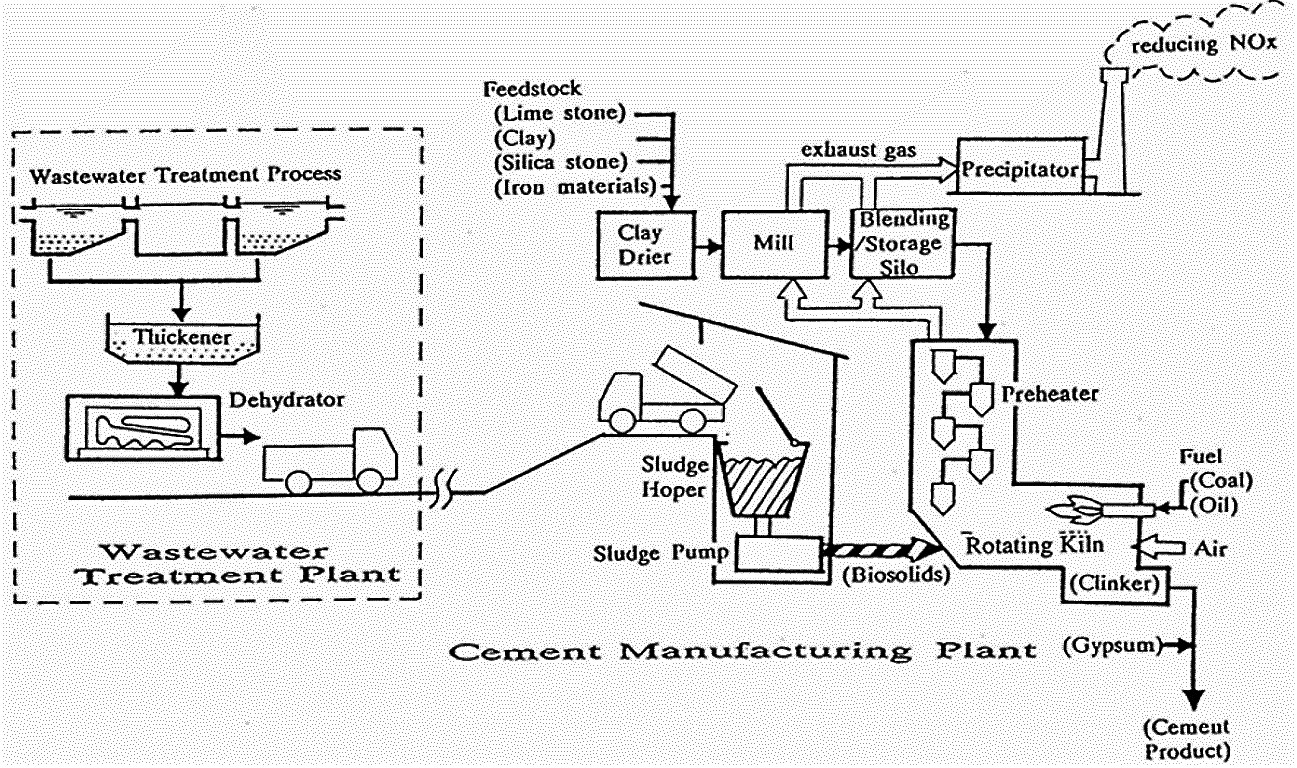
Another beneficial way to use both the inorganic and organic compounds of the sludge is the use of sludge in the production of Portland cement. In this process, which is also applied in practice, either ash or dried sludge can be used. Toxic organic pollutants in the sludge are completely oxidised, and because of the high process temperature, heavy metals are immobilised in the cement.
Supercritical Wet Oxidation of Sewage Sludge
Adapted from XU & LANCASTER (n.y.)
Supercritical Water Oxidation (SCWO), also referred to as hydrothermal oxidation, is a process that oxidises organic solutes in an aqueous medium using oxygen/air or hydrogen peroxide as oxidants, at temperatures and pressures above the critical point of water (374°C and 22 MPa). After reaction, the effluent is cooled and energy is recovered. According to Svanstrom et al. (2004), about half of the heating value of the sludge can be recovered in the studied process. The solid and liquid products are separated and the wet inorganic solids can be sent to a landfill or spread on dedicated land while the water can be redirected to a wastewater treatment plant.
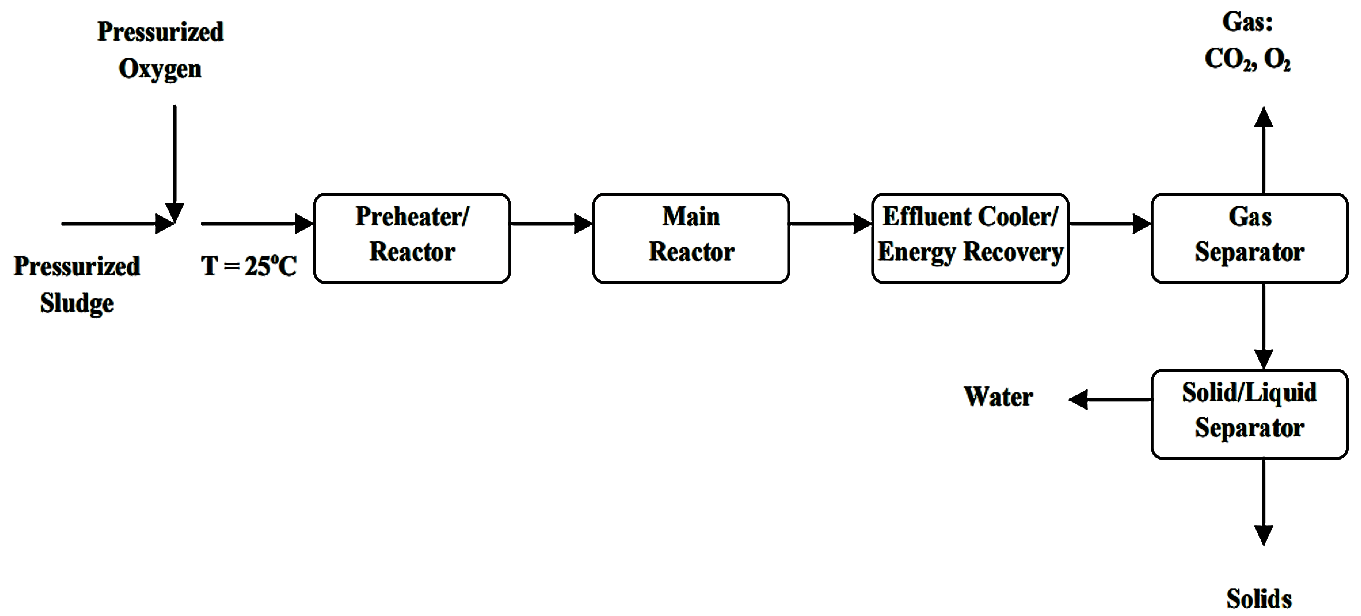
Hydrothermal Treatment of Sewage Sludge
Adapted from RULKENS (2007)
Hydrothermal treatment (or thermal hydrolysis) is a process in which the sludge is heated as an aqueous phase to temperatures (normally) varying between 120 and about 400°C. The hydrothermal treatment process aims to disintegrate the sludge and results in a formation and accumulation of dissolved products. This makes it possible to recover and recycle useful resources from the sludge, such as volatile fatty acids, phosphorous compounds, organic compounds for enhanced anaerobic biogas production, and coagulants. The potential of hydrothermal treatment for the recovery of energy from sewage sludge strongly depends upon the process performance.
Cost Considerations/Operation and Maintenance
The described methods and processes are highly engineered and therefore expensive and require expert knowledge and professional operators.
Some of the described techniques are still not fully developed. Others are already in use in wastewater treatment plants around the world. As already mentioned, these technologies are expensive and require engineering knowledge to guarantee a sustainable and long-term operation of the facility
Microbial Fuel Cells for Wastewater Treatment
Microbial fuel cells (MFCs) are emerging as promising technology for the treatment of wastewaters. The potential energy conversion efficiencies are examined. The rates of energy recovery (W/m3 reactor) are reviewed and evaluated. Some recent data relating to potato-processing wastewaters and a hospital wastewater effluent are reported. Finally, a set of process configurations in which MFCs could be useful to treat wastewaters is schematised. Overall, the MFC technology still faces major challenges, particularly in terms of chemical oxygen demand (COD) removal efficiency.
AELTERMAN, P. ; RABAEY, K. ; CLAUWAERT, P. ; VERSTRAETE, W. (2006): Microbial Fuel Cells for Wastewater Treatment. In: Water Science & Technology: Volume 54 , 9-15. URL [Accessed: 27.05.2019]Utilisation of Biomass for the Supply of Energy Carriers
In this mini-review, the `state of the art' of several fermentation processes is discussed, starting with the most advanced process of ethanol production.
CLAASSEN, P.A.M. ; LIER, J.B. van ; LOPEZ CONTRERAS, A.M. ; NIEL, E.W.J. van ; SIJTSMA, L. ; STAMS, A.J.M. ; VRIES, S.S. de ; WEUSTHUIS, R.A. (1999): Utilisation of Biomass for the Supply of Energy Carriers. In: Appl. Microbiol. Biotechnol: Volume 52 , 741-755. URL [Accessed: 27.05.2019]Brick Manufacturing From Water Treatment Sludge And Rice Husk Ash
For thousands of years, bricks have been made from clay. The water treatment plant sludge is extremely close to brick clay in chemical composition, suggesting that it could be a potential substitute for brick clay.
HEGAZY, BADR EL-DIN E. ; FOUAD, H.A. ; HASSANAIN, A.M. (2012): Brick Manufacturing From Water Treatment Sludge And Rice Husk Ash. In: Australian Journal of Basic and Applied Sciences: Volume 6 , 453-461. URL [Accessed: 24.07.2019]Layman Report: Sludge2Energy A Way to Energy Self-sufficient Sewage Treatment Plants
The aim of this project is to show that decentralised and virtually energy self-sufficient disposal of sewage sludge is possible with the use of intelligent process technology and optimised plant components. Well-proven plant components have been combined to create an innovative overall concept. Read more in this report.
HUBER (2011): Layman Report: Sludge2Energy A Way to Energy Self-sufficient Sewage Treatment Plants. Berching: HUBER SE URL [Accessed: 27.05.2019]Lightweight Aggregates from Sewage Sludge
This is a short project description about lightweight aggregates from sewage sludge.
IMBIGS (n.y): Lightweight Aggregates from Sewage Sludge. Warsaw: Institute of Mechanised Construction and Rock Mining URL [Accessed: 04.07.2012]Biodiesel Production from Municipal Sewage Sludges
Biodiesel production from sewage sludge poses huge challenges to overcome if commercial opportunities are to be realised. Some of these challenges are not unique to biodiesel production from waste sludge but to the biodiesel industry as a whole. They include challenges from (1) collecting the sludge, (2) optimum production of biodiesel, (3) maintaining product quality, (4) soap formation and product separation, (5) bioreactor design, (6) pharmaceutical chemicals in sludge, (7) regulatory concerns, and (8) economics of biodiesel production.
KARGBO, D.M. (2010): Biodiesel Production from Municipal Sewage Sludges. In: Energy Fuels 2010: Volume 24 , 2791–2794. URL [Accessed: 27.05.2019]Sewage Sludge Gasification
The first wastewater and sewage sludge gasification system in Japan commenced operations in town of Kiyose, Tokyo.
KAWASAKI, M. (2010): Sewage Sludge Gasification. In: Highlighting Japan. pp. 12-13. [Accessed: 04.07.2012]: PDFProduction of Electricity during Wastewater Treatment Using a Single Chamber Microbial Fuel Cell
Microbial fuel cells (MFCs) have been used to produce electricity from different compounds, including acetate, lactate, and glucose. In this report, it is demonstrated that it is also possible to produce electricity in a MFC from domestic wastewater, while at the same time accomplishing biological wastewater treatment (removal of chemical oxygen demand; COD).
LIU, H. ; RAMNARAYANAN, R. ; LOGAN, B.E. (2004): Production of Electricity during Wastewater Treatment Using a Single Chamber Microbial Fuel Cell. In: Environ. Sci. Technol.: Volume 38 , 2281-2285. URL [Accessed: 27.05.2019]Co-incineration of Sewage Sludge in Coal-Fuelled Power Stations
Sensible alternatives are being sought to the present method of disposing of mechanically de-watered sewage sludge such as dumping, agricultural use, drying and incineration.
PUTZMEISTER (2001): Co-incineration of Sewage Sludge in Coal-Fuelled Power Stations. Aichtal: Putzmeister Holding GmbH URL [Accessed: 27.05.2019]Sewage Sludge as a Biomass Resource
The aim of this paper, which is based on a literature review, is to discuss the various options to recover energy from sewage sludge and to assess qualitatively these options with respect to the development stage, potential of energy recovery, and expected future developments. In this evaluation the effect of the presence of toxic organic and inorganic components in the sludge is also assessed.
RULKENS, W. (2007): Sewage Sludge as a Biomass Resource. In: Energy & Fuels 2008: Volume 22 , 9–15. URL [Accessed: 27.05.2019]Glass-ceramic from Sewage Sludge
This study focused on the main components of sewage sludge incinerated ash, which are silicic acid and alumina, as well as the components for nucleation. Based on this idea, the production of glass-ceramic using sewage sludge incinerated ash as the main material has been attempted.
SUZUKI, S. ; TANAKA, M. ; KANEKO, T. (1997): Glass-ceramic from Sewage Sludge. In: Journal of Materials Science: Volume 32 , 1775-1779. URL [Accessed: 27.05.2019]Direct Energy Recovery from Primary and Secondary Sludges by Supercritical Water Oxidation
Reuse of Sewage Sludge as Raw Material of Portland Cement in Japan
This study focused on the main components of sewage sludge incinerated ash, which are silicic acid and alumina, as well as the components for nucleation. Based on this idea, the production of glass-ceramic using sewage sludge incinerated ash as the main material has been attempted.
TARUYA, T. ; OKUNO, N. ; KANAYA, K. (2002): Reuse of Sewage Sludge as Raw Material of Portland Cement in Japan. In: Water Sci. Technol.: Volume 46 , 255–258. URL [Accessed: 04.07.2012]Production of Hydrogen and Methane from Wastewater Sludge Using Anaerobic Fermentation
This study examined anaerobic fermentation of wastewater sludge, both original and pre-treated, by observing alterations in hydrogen and methane content utilising a clostridium strain. The pre-treatments were studied to demonstrate their effects to promote hydrogen production. The metabolised products were also assessed to gain insight into the utility of sequential production of hydrogen and methane from wastewater sludge. The original and pre-treated (acidified, freeze/thawed, and basified) wastewater sludges were tested.
TING, C.H. LEE, D.J. (2006): Production of Hydrogen and Methane from Wastewater Sludge Using Anaerobic Fermentation. Taipei: Department of Chemical Engineering, National Taiwan University. [Accessed: 04.07.2012] PDFUtilization of Sludge as Brick Materials
In this study, the suitable conditions of using dried sludge in manufacturing of bricks under the criteria of Chinese National Standards (CNS) were investigated. The influence of sludge proportion in the raw materials, the temperature in relating to the brick qualities, and metal leach ability were examined.
WENG, C.H. ; LIN, D.F. ; CHIANG, P.C. (2003): Utilization of Sludge as Brick Materials. In: Advances in Environmental Research: Volume 7 , 679–685. URL [Accessed: 04.07.2012]Portland Cement
Treatment of Secondary Sludge for Energy Recovery
In this chapter, a variety of secondary sludge post treatment methods for energy recovery, including incineration, gasification, pyrolysis, direct liquefaction, supercritical water oxidation (SCWO) and anaerobic digestion were overviewed. A critical comparison between these methods is presented with respect to their net energy efficiencies. The advantages and drawbacks of each treatment option are also highlighted.
XU, C.C. LANCASTER, J. (n.y): Treatment of Secondary Sludge for Energy Recovery. Thunderbay: Department of Chemical Engineering, Lakehead University URL [Accessed: 27.05.2019]Microbial Fuel Cells for Wastewater Treatment
Microbial fuel cells (MFCs) are emerging as promising technology for the treatment of wastewaters. The potential energy conversion efficiencies are examined. The rates of energy recovery (W/m3 reactor) are reviewed and evaluated. Some recent data relating to potato-processing wastewaters and a hospital wastewater effluent are reported. Finally, a set of process configurations in which MFCs could be useful to treat wastewaters is schematised. Overall, the MFC technology still faces major challenges, particularly in terms of chemical oxygen demand (COD) removal efficiency.
AELTERMAN, P. ; RABAEY, K. ; CLAUWAERT, P. ; VERSTRAETE, W. (2006): Microbial Fuel Cells for Wastewater Treatment. In: Water Science & Technology: Volume 54 , 9-15. URL [Accessed: 27.05.2019]Utilisation of Biomass for the Supply of Energy Carriers
In this mini-review, the `state of the art' of several fermentation processes is discussed, starting with the most advanced process of ethanol production.
CLAASSEN, P.A.M. ; LIER, J.B. van ; LOPEZ CONTRERAS, A.M. ; NIEL, E.W.J. van ; SIJTSMA, L. ; STAMS, A.J.M. ; VRIES, S.S. de ; WEUSTHUIS, R.A. (1999): Utilisation of Biomass for the Supply of Energy Carriers. In: Appl. Microbiol. Biotechnol: Volume 52 , 741-755. URL [Accessed: 27.05.2019]Supercritical Water Oxidation of Sewage Sludge – State of the Art
Supercritical water oxidation (SCWO) is an innovative and effective destruction method for organic wastewater and sludge. Several tests of the destruction of sewage sludge by SCWO have been done at two state-of-the-art pilot plants.
GIDNER , A. STENMARK, L. (n.y): Supercritical Water Oxidation of Sewage Sludge – State of the Art. Karlskoga: Chematur Engineering AB URL [Accessed: 27.05.2019]Sludge Treatment
In this report a good collection of Nordic innovative companies and their products are introduced. The report highlights some examples in the key technologies. It can be seen that in the Nordic countries there is a good industry base to cover the most promising recent innovative technologies.
GREENNET FINLAND (n.y): Sludge Treatment. Vantaa: Greennet Finland URL [Accessed: 27.05.2019]Brick Manufacturing From Water Treatment Sludge And Rice Husk Ash
For thousands of years, bricks have been made from clay. The water treatment plant sludge is extremely close to brick clay in chemical composition, suggesting that it could be a potential substitute for brick clay.
HEGAZY, BADR EL-DIN E. ; FOUAD, H.A. ; HASSANAIN, A.M. (2012): Brick Manufacturing From Water Treatment Sludge And Rice Husk Ash. In: Australian Journal of Basic and Applied Sciences: Volume 6 , 453-461. URL [Accessed: 24.07.2019]Layman Report: Sludge2Energy A Way to Energy Self-sufficient Sewage Treatment Plants
The aim of this project is to show that decentralised and virtually energy self-sufficient disposal of sewage sludge is possible with the use of intelligent process technology and optimised plant components. Well-proven plant components have been combined to create an innovative overall concept. Read more in this report.
HUBER (2011): Layman Report: Sludge2Energy A Way to Energy Self-sufficient Sewage Treatment Plants. Berching: HUBER SE URL [Accessed: 27.05.2019]Lightweight Aggregates from Sewage Sludge
This is a short project description about lightweight aggregates from sewage sludge.
IMBIGS (n.y): Lightweight Aggregates from Sewage Sludge. Warsaw: Institute of Mechanised Construction and Rock Mining URL [Accessed: 04.07.2012]Biodiesel Production from Municipal Sewage Sludges
Biodiesel production from sewage sludge poses huge challenges to overcome if commercial opportunities are to be realised. Some of these challenges are not unique to biodiesel production from waste sludge but to the biodiesel industry as a whole. They include challenges from (1) collecting the sludge, (2) optimum production of biodiesel, (3) maintaining product quality, (4) soap formation and product separation, (5) bioreactor design, (6) pharmaceutical chemicals in sludge, (7) regulatory concerns, and (8) economics of biodiesel production.
KARGBO, D.M. (2010): Biodiesel Production from Municipal Sewage Sludges. In: Energy Fuels 2010: Volume 24 , 2791–2794. URL [Accessed: 27.05.2019]Production of Electricity during Wastewater Treatment Using a Single Chamber Microbial Fuel Cell
Microbial fuel cells (MFCs) have been used to produce electricity from different compounds, including acetate, lactate, and glucose. In this report, it is demonstrated that it is also possible to produce electricity in a MFC from domestic wastewater, while at the same time accomplishing biological wastewater treatment (removal of chemical oxygen demand; COD).
LIU, H. ; RAMNARAYANAN, R. ; LOGAN, B.E. (2004): Production of Electricity during Wastewater Treatment Using a Single Chamber Microbial Fuel Cell. In: Environ. Sci. Technol.: Volume 38 , 2281-2285. URL [Accessed: 27.05.2019]Co-incineration of Sewage Sludge in Coal-Fuelled Power Stations
Sensible alternatives are being sought to the present method of disposing of mechanically de-watered sewage sludge such as dumping, agricultural use, drying and incineration.
PUTZMEISTER (2001): Co-incineration of Sewage Sludge in Coal-Fuelled Power Stations. Aichtal: Putzmeister Holding GmbH URL [Accessed: 27.05.2019]Sewage Sludge as a Biomass Resource
The aim of this paper, which is based on a literature review, is to discuss the various options to recover energy from sewage sludge and to assess qualitatively these options with respect to the development stage, potential of energy recovery, and expected future developments. In this evaluation the effect of the presence of toxic organic and inorganic components in the sludge is also assessed.
RULKENS, W. (2007): Sewage Sludge as a Biomass Resource. In: Energy & Fuels 2008: Volume 22 , 9–15. URL [Accessed: 27.05.2019]Glass-ceramic from Sewage Sludge
This study focused on the main components of sewage sludge incinerated ash, which are silicic acid and alumina, as well as the components for nucleation. Based on this idea, the production of glass-ceramic using sewage sludge incinerated ash as the main material has been attempted.
SUZUKI, S. ; TANAKA, M. ; KANEKO, T. (1997): Glass-ceramic from Sewage Sludge. In: Journal of Materials Science: Volume 32 , 1775-1779. URL [Accessed: 27.05.2019]Reuse of Sewage Sludge as Raw Material of Portland Cement in Japan
This study focused on the main components of sewage sludge incinerated ash, which are silicic acid and alumina, as well as the components for nucleation. Based on this idea, the production of glass-ceramic using sewage sludge incinerated ash as the main material has been attempted.
TARUYA, T. ; OKUNO, N. ; KANAYA, K. (2002): Reuse of Sewage Sludge as Raw Material of Portland Cement in Japan. In: Water Sci. Technol.: Volume 46 , 255–258. URL [Accessed: 04.07.2012]Production of Hydrogen and Methane from Wastewater Sludge Using Anaerobic Fermentation
This study examined anaerobic fermentation of wastewater sludge, both original and pre-treated, by observing alterations in hydrogen and methane content utilising a clostridium strain. The pre-treatments were studied to demonstrate their effects to promote hydrogen production. The metabolised products were also assessed to gain insight into the utility of sequential production of hydrogen and methane from wastewater sludge. The original and pre-treated (acidified, freeze/thawed, and basified) wastewater sludges were tested.
TING, C.H. LEE, D.J. (2006): Production of Hydrogen and Methane from Wastewater Sludge Using Anaerobic Fermentation. Taipei: Department of Chemical Engineering, National Taiwan University. [Accessed: 04.07.2012] PDFUtilization of Sludge as Brick Materials
In this study, the suitable conditions of using dried sludge in manufacturing of bricks under the criteria of Chinese National Standards (CNS) were investigated. The influence of sludge proportion in the raw materials, the temperature in relating to the brick qualities, and metal leach ability were examined.
WENG, C.H. ; LIN, D.F. ; CHIANG, P.C. (2003): Utilization of Sludge as Brick Materials. In: Advances in Environmental Research: Volume 7 , 679–685. URL [Accessed: 04.07.2012]Treatment of Secondary Sludge for Energy Recovery
In this chapter, a variety of secondary sludge post treatment methods for energy recovery, including incineration, gasification, pyrolysis, direct liquefaction, supercritical water oxidation (SCWO) and anaerobic digestion were overviewed. A critical comparison between these methods is presented with respect to their net energy efficiencies. The advantages and drawbacks of each treatment option are also highlighted.
XU, C.C. LANCASTER, J. (n.y): Treatment of Secondary Sludge for Energy Recovery. Thunderbay: Department of Chemical Engineering, Lakehead University URL [Accessed: 27.05.2019]Sewage Sludge Gasification
The first wastewater and sewage sludge gasification system in Japan commenced operations in town of Kiyose, Tokyo.
KAWASAKI, M. (2010): Sewage Sludge Gasification. In: Highlighting Japan. pp. 12-13. [Accessed: 04.07.2012]: PDFSludge-to-Energy Process Solves Disposal Problems in Poland
The Cambi thermal hydrolysis process digester retrofit reduced by half the quantity of final dewatered sludge cake at the Kapusciska wastewater treatment plant in Poland.
KAWECKI, S. ; PASTWA, P. ; KLEIVEN, H. (2007): Sludge-to-Energy Process Solves Disposal Problems in Poland. In: World Water and Environmental Engineering: Volume 43 URL [Accessed: 04.07.2012] PDF

